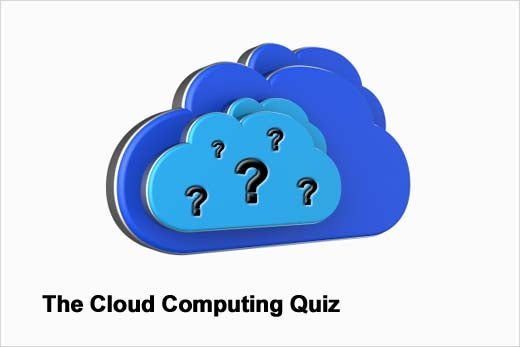Cloud computing has been around for a while now. When correctly implemented, its scalability and flexibility increases productivity, saving both time and money. But although the cloud is still being touted as the future of IT, many organizations have yet to adopt it. And, really, who can blame them? Private, public, hybrid, and not to mention all of the “as a service” options – it’s hard to know which one is a right fit for your organization.
With the cloud and any new-to-you technology, it’s important to do your research before making the leap so that you can reap the benefits; otherwise, you risk losing any money and time that you have invested in it.
To help you get started, we’ve created a quiz that will test your own knowledge of the cloud before you move to adoption. It’s a great jumping off point for getting the cloud conversation started.
After taking the quiz, be sure to check out these other cloud-related posts on IT Business Edge. In “The Cloud: Not Just the Same Old IT,” Arthur Cole breaks down why the cloud is different from internal data environments. Also, it might be good to pass out these cloud-specific terms and definitions so that IT and the business side are on the same page. And, last but not least, this slideshow looks at why it’s important to consider your network before moving to the cloud.
Click through for seven questions that will test your knowledge of the cloud.
Question: Which of these is NOT a cloud deployment model?
A. public cloud
B. private cloud
C. cross-platform cloud
D. hybrid cloud
Question: Which of these is NOT a cloud deployment model?
Answer: C. Cross-platform cloud
Learn more: How to Choose the Right Cloud
True or False? Private clouds cannot be customized to suit your organization’s unique data requirements.
True or False? Private clouds cannot be customized to suit your organization’s unique data requirements.
Answer: False
Learn more: The True Value of the Private Cloud
Question: Which service model enables the subscriber to use processing, storage, networks and other computing resources, and to deploy and run other software, including operating systems and applications?
A. platform as a service
B. software as a service
C. infrastructure as a service
D. none of the above
Question: Which service model enables the subscriber to use processing, storage, networks and other computing resources, and to deploy and run other software, including operating systems and applications?
Answer: C. infrastructure as a service
True or False? The platform-as-a-service model is concerned with delivering primarily virtualized computing environments across one or more clouds.
True or False? The platform-as-a-service model is concerned with delivering primarily virtualized computing environments across one or more clouds.
Answer: True
Learn more: PaaS and the Private Cloud
Question: Which of these cloud service models splits the difference between the benefits and liabilities of public and private clouds?
A. public cloud
B. community cloud
C. on-site private cloud
D. hybrid cloud
Question: Which of these cloud service models splits the difference between the benefits and liabilities of public and private clouds?
Answer: C. hybrid cloud
Learn more: The Future Belongs to the Hybrid Cloud
True or False? Cloud services and applications typically have no up-front costs, and instead bill on a regular basis depending on how much you use.
True or False? Cloud services and applications typically have no up-front costs, and instead bill on a regular basis depending on how much you use.
Answer: True
Learn more: Moving to the Cloud: Where, When and How to Start
True or False? A Statement of Work agreement covers objectives, tasks and deliverables for a cloud migration, with both schedules and costs laid out in explicit detail.
True or False? A Statement of Work agreement covers objectives, tasks and deliverables for a cloud migration, with both schedules and costs laid out in explicit detail.
Answer: True
Learn more: The Migration Cometh Before the Cloud

















